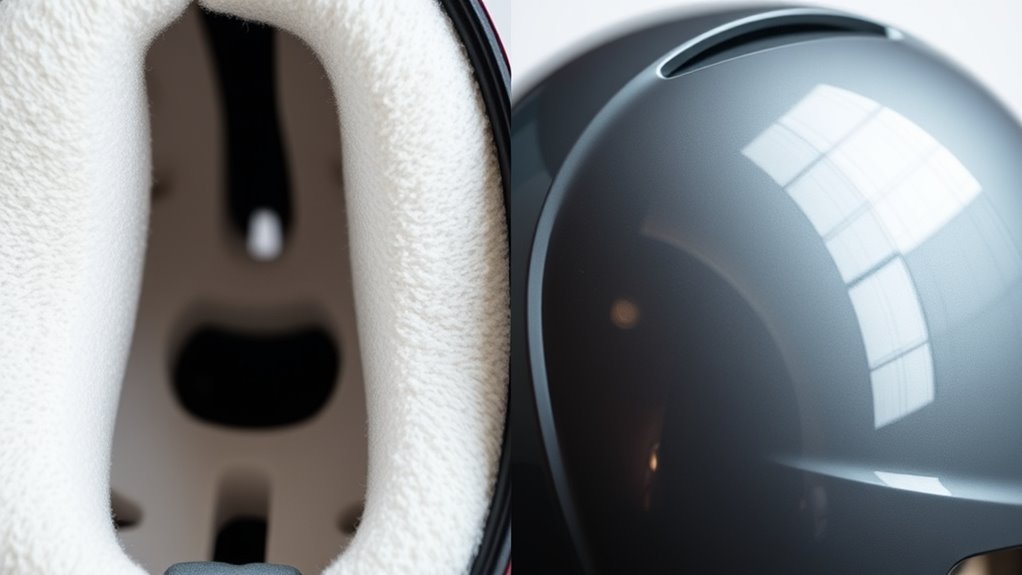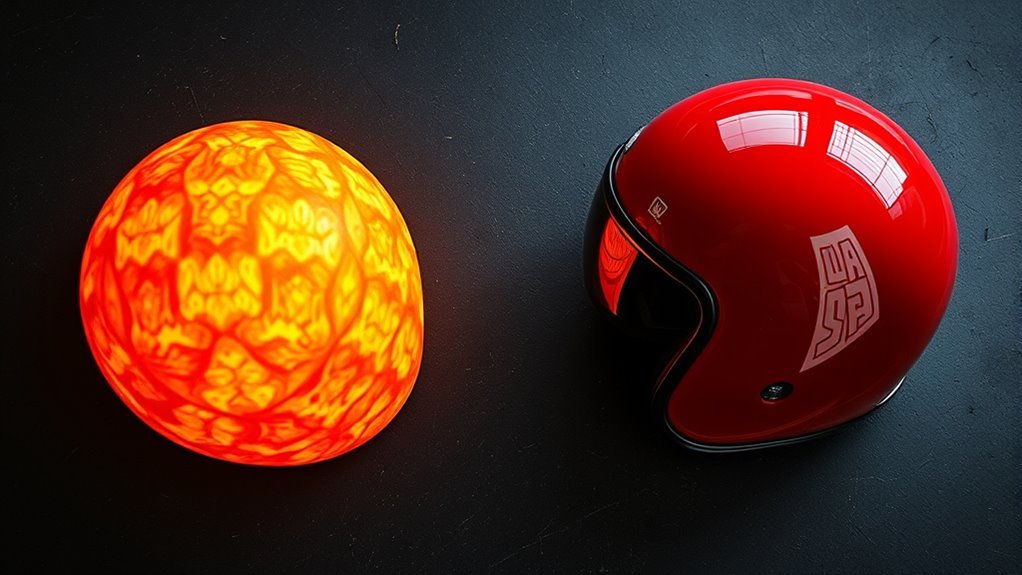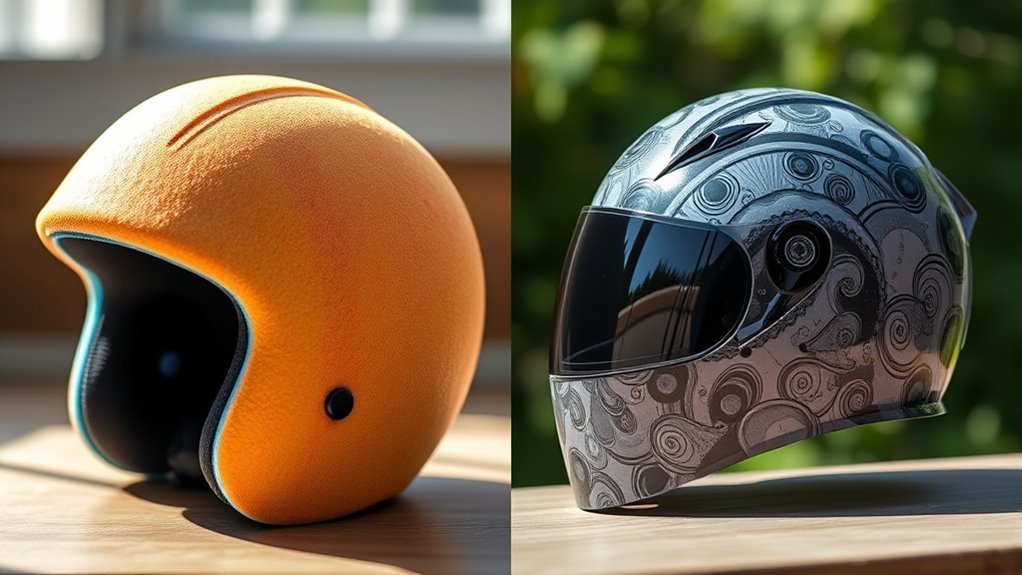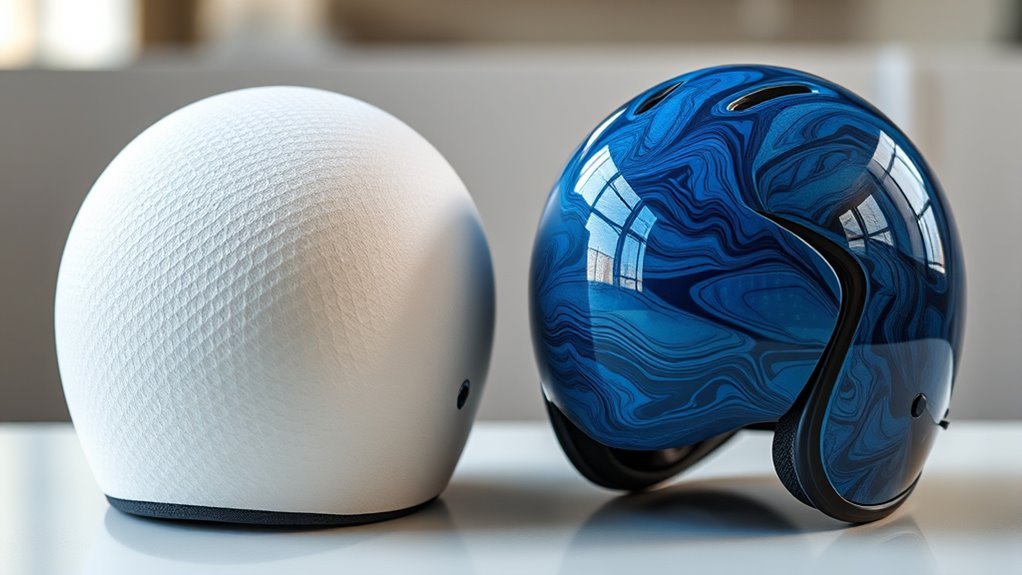Foam vs. Resin for Helmet Making
When choosing between foam and resin for helmet making, consider their distinct properties. Foam helmets excel in shock absorption, offering lightweight comfort but may degrade over time. Resin helmets provide superior impact resistance and durability, ideal for high-performance needs, though they can be heavier and potentially less comfortable. Balancing safety, comfort, and cost is essential, as each material serves different applications. Explore the nuances of each option to make an informed decision.
Overview of Foam and Resin Materials

When it comes to helmet making, understanding the materials involved is vital. The foam properties, such as density and compressibility, directly affect the helmet’s ability to absorb impact energy. High-density foams offer superior shock absorption, while lower-density options can be lighter but may compromise protection. On the other hand, resin characteristics play a significant role in the structural integrity of the helmet. Resins provide a rigid outer shell, ensuring durability and resistance to environmental factors. Their curing process affects hardness and flexibility, which impacts overall performance. Balancing foam and resin in helmet design allows for ideal safety and comfort, catering to your desire for freedom without sacrificing protection. Knowing these material properties helps you make informed decisions in helmet selection.
Safety Features of Foam Helmets

Although foam helmets may appear less robust than their resin counterparts, they incorporate several critical safety features that enhance protection during impact. The foam structure effectively absorbs energy, minimizing the forces transmitted to your head upon collision. This property is essential for impact protection, as it disperses the energy over a larger area, reducing the risk of concussions and other head injuries. Additionally, foam helmets often feature multi-density layers, allowing for tailored protection based on specific impact scenarios. They’re also lightweight, ensuring comfort and ease of use, which can encourage consistent wear. Ultimately, the innovative design of foam helmets prioritizes safety while maintaining a balance of comfort and freedom, making them a viable option for various activities.
Safety Features of Resin Helmets

While foam helmets excel in energy absorption, resin helmets offer distinct safety features that enhance overall head protection. One of the primary advantages of resin helmets is their superior impact resistance. This material can withstand high-velocity impacts without compromising structural integrity, making it ideal for high-risk activities. Resin helmets typically meet or exceed stringent safety standards, ensuring they provide reliable protection in critical situations. Additionally, the rigid outer shell of resin helmets can effectively dissipate force, reducing the risk of concussions. With a precise fit, these helmets minimize movement upon impact, further enhancing safety. For those who prioritize both performance and protection, the advanced safety features of resin helmets are a compelling choice, offering freedom without sacrificing security.
Weight and Comfort Comparison
When evaluating helmet materials, weight plays a vital role in overall comfort. Foam helmets are generally lighter, which can enhance wearability during extended use, while resin helmets often provide a sturdier feel but may increase fatigue over time. Understanding these differences is essential for selecting the right helmet for your needs.
Weight Differences
Weight plays an essential role in helmet design, directly impacting both comfort and performance. When comparing foam and resin helmets, you’ll notice significant differences in weight distribution and overall helmet balance. A well-balanced helmet reduces strain on your neck and enhances your riding experience.
- Foam Helmets: Generally lighter, providing a more comfortable feel during long rides.
- Resin Helmets: Heavier, but offer greater durability and impact resistance, which might be critical for safety.
- Weight Distribution: Properly distributed weight in either material affects how you perceive the helmet’s comfort and stability.
Ultimately, your choice depends on whether you prioritize lightweight comfort or the added protection that heavier materials may provide. Understanding these weight differences will guide you in making an informed decision.
Comfort Levels
Comfort levels in helmet design are closely tied to the materials used, impacting how riders experience prolonged wear. Foam helmets typically offer superior padding options, allowing for better fit adjustments, which can enhance comfort during extended rides. Conversely, resin helmets are often lighter but may sacrifice some padding, leading to increased pressure points.
Here’s a comparison of comfort-related characteristics:
| Material | Weight | Padding Options |
|---|---|---|
| Foam | Heavier | High |
| Resin | Lighter | Moderate |
| Foam | Heavier | Adjustable |
| Resin | Lighter | Fixed |
Ultimately, your choice should balance weight and comfort, ensuring you feel free and focused on the ride. Prioritizing fit adjustments and padding options can greatly enhance your helmet experience.
Durability and Impact Resistance
When evaluating durability and impact resistance in helmet materials, it’s crucial to compare the strength of foam and resin. You’ll need to reflect on each material’s ability to absorb impacts and how well they maintain their integrity under stress over time. Analyzing these factors will help you determine which option offers superior protection for your specific needs.
Material Strength Comparison
The fundamental difference between foam and resin in helmet construction lies in their material strength, particularly regarding durability and impact resistance. When considering the material properties and manufacturing processes, you’ll notice significant distinctions:
- Foam: Lightweight, offering decent flexibility but may degrade over time, especially under extreme conditions.
- Resin: Provides superior rigidity and longevity, making it more resilient against wear and tear.
- Impact Resistance: Resin typically withstands higher impacts, ensuring better protection during collisions.
Impact Absorption Capabilities
While both foam and resin serve as critical components in helmet construction, their impact absorption capabilities differ considerably, influencing their effectiveness in protecting the wearer. Foam generally excels in energy dissipation, absorbing impacts through deformation, which reduces the force transmitted to your head. In contrast, resin can provide a stiffer, less deformable structure, potentially leading to higher impact performance in certain scenarios but may transmit more force without adequate cushioning.
| Material | Energy Dissipation | Impact Performance |
|---|---|---|
| Foam | High | Moderate |
| Resin | Moderate | High |
Understanding these differences can help you make an informed choice regarding the level of protection you need in your helmet design.
Longevity Under Stress
Although both foam and resin have their strengths, their longevity under stress presents crucial differences that impact helmet durability and overall performance. When it comes to stress testing, you’ll notice distinct material performance characteristics:
- Foam: Generally offers excellent impact absorption but can degrade faster with repeated stress exposure, losing structural integrity over time.
- Resin: Typically exhibits higher durability under prolonged stress, maintaining its shape and performance but may crack under extreme impact if not designed properly.
- Combination: Utilizing both materials can enhance overall durability, balancing flexibility and resistance.
Choosing the right material is essential for ensuring your helmet withstands the rigors of use while providing the necessary protection and comfort. Understanding these differences allows you to make a more informed decision.
Cost Analysis of Foam vs. Resin
When evaluating the cost implications of using foam versus resin in helmet manufacturing, it is crucial to take into account not just the raw material prices but also the long-term financial impacts associated with each option. Foam generally presents lower upfront costs, making it favorable for tight budget considerations. However, consider the cost factors of durability and replacement frequency. Resin, while more expensive initially, often yields greater longevity and performance, potentially reducing long-term expenses. You’ll need to weigh these aspects against your production scale and target market. Ultimately, understanding how each material aligns with your financial strategy will empower you to make an informed decision that supports both your budget and your commitment to quality.
Applications and Use Cases
As you explore the applications and use cases for foam and resin in helmet making, it is essential to recognize that each material serves distinct purposes based on performance requirements and user demographics. Foam is often favored for its lightweight nature and shock-absorbent qualities, making it ideal for activities like cycling and skateboarding. In contrast, resin provides durability and a sleek finish, appealing to those in motorsports or custom designs.
Exploring foam and resin in helmet making reveals their unique benefits for various activities and user needs.
Consider these applications:
- Foam: Ideal for recreational helmets, balancing comfort and protection.
- Resin: Suitable for professional-grade helmets requiring enhanced strength.
- Custom Designs: Both materials can be tailored to meet specific user preferences, ensuring safety without sacrificing style.
Environmental Considerations in Material Choice
While selecting materials for helmet making, it’s essential to contemplate their environmental impact. You’ll want to evaluate both foam and resin through the lens of sustainability practices. Foam, often made from petroleum-based products, may present challenges regarding biodegradability, whereas some resins can be engineered to be more eco-friendly. Consider the recycling options available for each material; some foams can be recycled, but many are not. Resins, depending on their formulation, might offer better recycling capabilities, particularly if they’re thermoplastic. Ultimately, your choice should align with your commitment to reducing waste and promoting environmental stewardship. By prioritizing sustainable materials, you not only improve helmet safety but also contribute positively to the planet’s health.
Frequently Asked Questions
Can I Mix Foam and Resin for Helmet Making?
Yes, you can mix foam and resin for helmet making, but you need to take into account material compatibility. Using proper mixing techniques is vital; guarantee the foam can withstand resin’s chemical properties without degrading. It’s essential to test small samples before full-scale application. This combination can enhance structural integrity and comfort, but be cautious of weight and flexibility. Experimenting with ratios will help you find the right balance for your desired outcome.
How Do I Properly Care for Foam Helmets?
“An ounce of prevention is worth a pound of cure.” To properly care for your foam helmet, focus on foam maintenance tips like regular cleaning. Use mild soap and water for cleaning techniques, avoiding harsh chemicals that can degrade the material. After washing, allow it to air dry completely to prevent mildew. Store it in a cool, dry place, and avoid excessive heat or direct sunlight to maintain its shape and integrity.
What Tools Are Needed for Resin Helmet Making?
For resin helmet making, you’ll need specific tools: a mixing cup, stir sticks, gloves, and a respirator mask for safety. You’ll also require a heat gun for curing, along with molds to shape the helmet. Understanding resin properties, like its viscosity and curing time, is essential. While foam types offer flexibility, resin provides durability and structural integrity, ensuring your helmet withstands impact while maintaining a sleek appearance.
Are There Specific Brands Recommended for Foam or Resin?
When it comes to brands, you’ll find that options like EVA Foam and Smooth-On for resin are highly regarded. In brand comparisons, EVA Foam offers flexibility and comfort, while Smooth-On showcases superior material performance and durability. Think of these brands as the compass guiding your creative journey. Each choice symbolizes a path toward freedom in design, allowing you to express your unique vision while ensuring safety and functionality in every helmet you create.
How Do I Customize the Fit of a Foam Helmet?
To customize the fit of a foam helmet, you’ll need to focus on fit adjustment techniques. Start by using padding options like foam strips or removable liners to fill gaps and enhance comfort. Adjust the retention system to guarantee a snug fit without excessive pressure. You might also consider using heat-molding methods for a more precise fit. Regularly check the helmet’s positioning for ideal safety during use.






